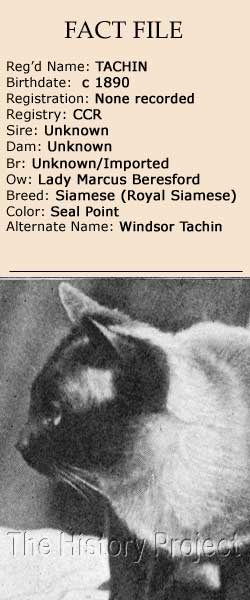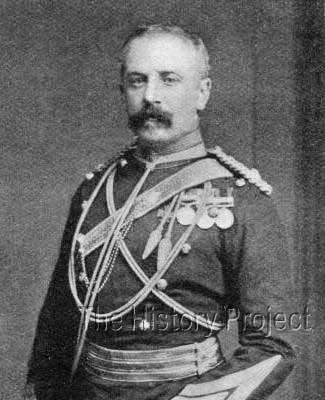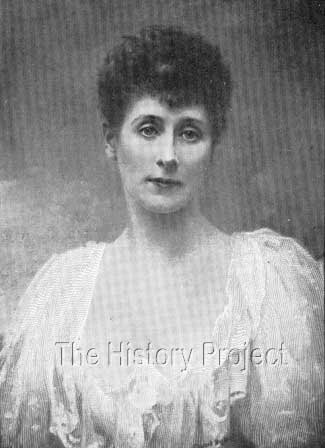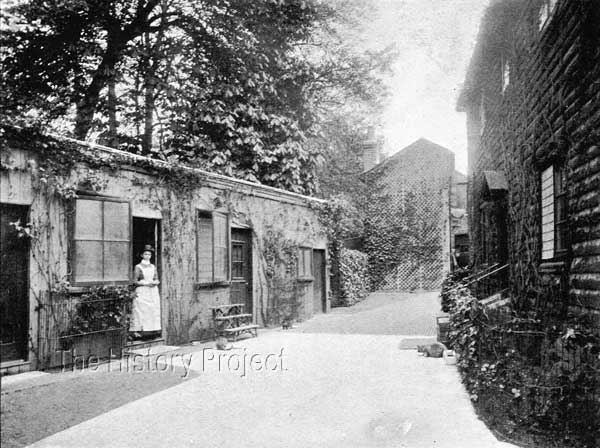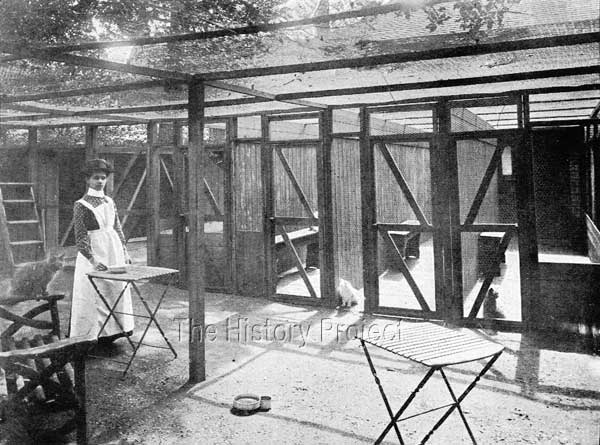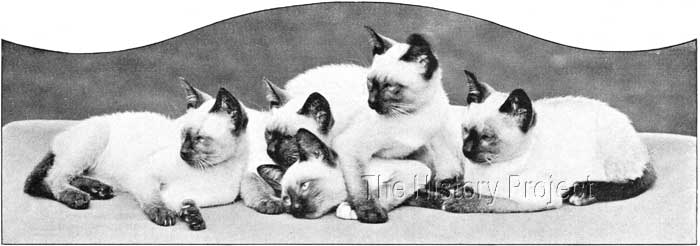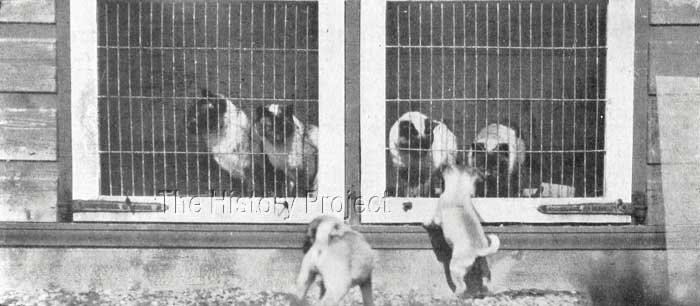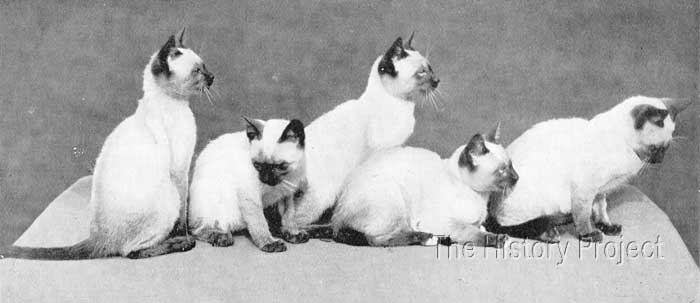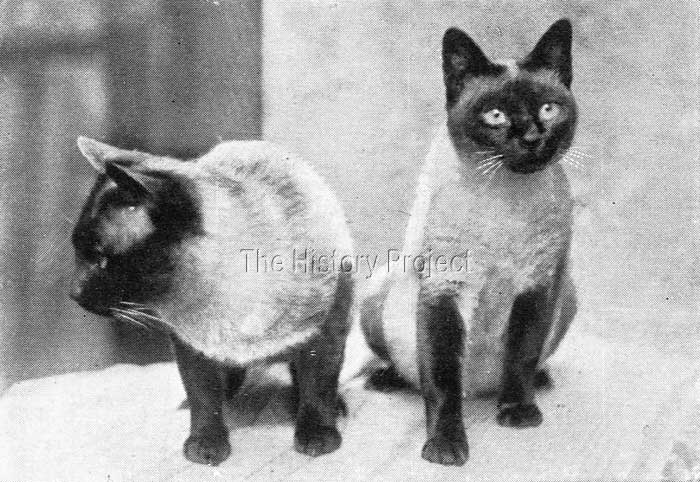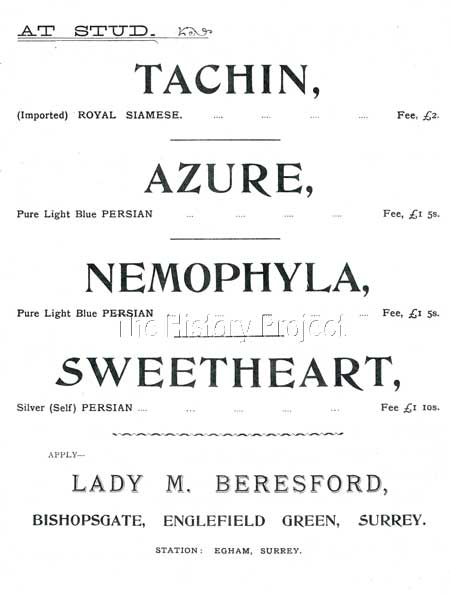 | ||||||||||||||||||||||||||||||||||||||||||||||||||









|
TACHIN (c1890)PHOTOS | SOCIAL MEDIA | REFERENCES | PDF FILE (Felis Historica)
HISTORICAL BACKGROUND:The story of 'Tachin' is inextricably linked with that of Lady Marcus Beresford, of whom it has been said, "There is no doubt in the mind of any one that she is the best friend the cat and cat fancier ever possessed"2. Frances Simpson gives the following account of feline life at 'Bishopsgate', the home of Lord and Lady Marcus Beresford: "Truly the lives of inmates of the Bishopsgate catteries are spent in peace and plenty, and when their little span of life is over, they find a resting place under the shadow of the grand old trees, and a little white tombstone with a loving inscription marks the spot of pussy's last long sleep.1 "Lady Marcus Beresford has had almost every breed of cat under the sun at her catteries, but of recent years she has specially taken up silvers, blues and Siamese, and a grand specimen of each of these varieties is in the stud at Bishopsgate.1 "Amongst some of the celebrated cats owned by Lady Marcus Beresford I may mention 'Lifeguard', a grand orange of massive build,; 'Tachin' and 'Cambodia' two imported Siamese with perfect points; 'Cora', a tortoiseshell and white of great beauty, and 'Kismet', a brown tabby of exquisite shape, both imported; and 'Cossy', a smoke that has found a home in America. At the present time, three of the most notable inmates of the Bishopsgate cattery, representing blues, silvers and Siamese, are 'Blue Boy II', 'Beetle' , and 'King of Siam'."1 Like many of the early fanciers, Lady Marcus was quite smitten by the many unique and endearing charms of the Siamese cat. They were in her opinion, the most intelligent of all the cat breeds. Among the very earliest owners and breeders of Siamese was Lady Dorothy Nevill, whose cats were observed on her estate at 'Dangstein', near Petersfield, by Harrison Weir and are mentioned in his book Our Cats published in 1889. In her own memoirs she writes of Weir and mentions an illustration rendered by him of one of her cats: "Mr. Weir made the most delightful sepia sketches, and amongst my treasures I especially value the portrait of a lovely Siamese cat which he painted for me. He was also a proficient in the art of portraying wild Nature, whilst in sketching birds, his talent has never since been equalled."1 Lady Dorothy was involved with the earliest cat shows, and in fact judged at the second Crystal Palace Show in December of 1871. It is highly probable that the sketch done by Harrison Weir could have been of her Siamese female, named 'Mrs. Poodle', who was a Gold Medal winner at one of the early shows. Harrison Weir in commenting on Siamese, in turn mentions 'Mrs. Poodle': "The one exhibited by Lady Dorothy Nevill (Mrs. Poodle) had three kittens by an English cat; but none showed any trace of the Siamese, being all tabby."8 "Lady Dorothy Nevill informed me that those which belonged to her were imported from Siam and presented by Sir R. Herbert of the Colonial Office; the late Duke of Wellington imported the breed, also Mr. Scott of Rotherfield."8
The first Siamese cats to appear at a cat show were those owned and exhibited by Mr. J. Maxwell at the very first Crystal Palace Show at Sydenham, in July of 1871. Lady Dorothy is known to have followed suit, most probably at the third Crystal Palace Show, held in May of 1872. What this tends to suggest, is that Siamese had already been imported into England as early as the 1860's. Mr. Maxwell owned a Siamese female named 'Mimie' who was shown subsequently at the Crystal Palace in 1875, along with a very young litter of kittens. It is reported that by then she was already five years old, which places her date of birth back into 1870. This means that she, or her siblings, may very well have been one of those to first appear at the first Crystal Palace Show in July, 1871. For her part, Lady Dorothy Nevill, along with her friend and eminent naturalist Mr. Charles Darwin, jointly acted as sponsors for the Crystal Palace Cat Show of 1875. Whilst Lady Dorothy genuinely tried to interest Mr. Darwin in her Siamese cats, his interest was instead piqued by those cats which displayed the traits of polydactyly (extra toes). These clearly whetted his obvious appetite for natural mutations, as part and parcel of evolutionary development. Another early and active breeder and fancier of Siamese during the latter part of this decade was Mrs. Cunliffe Lee who was a regular exhibitor of both Siamese cats and kittens. She was also the owner of the celebrated 'Meo' who was later to feature in the pedigrees of the follow-on 'Tiam O'Shians', produced through the combined efforts of Mrs. Vyvyan and her sister Mrs. Forestier Walker. It was these ladies, who, having first made acquaintance with the breed in 1883, were soon after presented with 'Susan' and 'Samuel' direct from the Palace at Bangkok. Later, 'Tiam O'Shian I', one of their most important and influential acquisitions, would likewise come out of Bangkok.
In 1884, the British Consul General in Bangkok, Edward Blencoe Gould, brought a breeding pair of Siamese, 'Pho' and 'Mia' to England as a gift for his sister, Lilian Jane Gould (later Mrs. Veley). From 'Pho' and 'Mia', in two separate litters, were produced 'Duen Ngai', 'Kalohom' and 'Khromata', who were shown as kittens at the Crystal Palace in 1885 but whom regretfully later died. Mrs. Vyvyan was in China when 'Susan' and 'Samuel' reached her, and in the following year (1886), she arranged to import another breeding pair, along with their two kittens. Within a year or two, she and Mrs. Forestier Walker were successfully establishing a reliable breeding strain of Siamese in the form of the 'Tiam O'Shian' stud males. These, in their turn, assisted many other fanciers establish their own independent lines. Mr. Young of Harrogate was also among the early breeders who established an independent strain in the later part of the 1880's. It was the early 1890's by the time Lady Marcus Beresford entered the scene with 'Tachin' and 'Cambodia' and by this time also, Mr. Elliott Hill, who was based in Ireland, had imported his foundation cats 'Siam I' and 'Siamese Cheetah'. The latter, like 'Cambodia' would soon prove her worth as an invaluable and remarkably reliable brood queen. It was into this emerging landscape, and against this rising tide of Siamese breeders and fanciers, that 'Tachin' and his companion 'Cambodia' arrived to carve their place in the history of the breed. Very soon afterward, they were followed Mrs. Sutherland's 'Prince of Siam', Mrs. Spencer's 'Royal Siam' and Mrs. Robinson's 'Wankee'. By this time, there was a plethora of new and enthusiastic breeders of Siamese, many of whom were already well-known figures throughout the feline establishment. These included the likes of The Hon. Mrs. McLaren Morrison, Mrs. Carew-Cox, Lady Gertrude Decies, Mrs. Sutherland, Mrs. Hankey, Miss Cochran, Mrs. Hawkins, Mrs. Backhouse and Mrs. Armitage to name just a few. PARENTAGE & OWNERSHIP:'Tachin' appears in The Cat Club Register with no date of birth, no sire or dam, but simply as a 'Royal Siamese Male, owned by Lady Marcus Beresford, of Bishopsgate, Englefield Green, Surrey.5
Unknown
Unknown
| Unknown
Tachin, circa 1890, Seal Point Siamese, M
| Unknown
Unknown
Unknown
'Tachin' was, in fact, sourced by Lord William Beresford, elder brother to Lord Marcus, while the former served as Military Secretary to the Viceroy of India. Upon securing both the Siamese male and a companion female named 'Cambodia', both cats were duly dispatched to England. This link to Lord William Beresford is seldom reported in any official history of the Siamese breed, but is none-the-less significant, as by looking at the image of 'Tachin' and 'Cambodia' together, one cannot help but be struck by the quality and beauty of both these cats. The only claim that has been made with respect to a connection to the Palace at Bangkok, is found in Frances Simpson's The Book of the Cat (1903), in which she states: "In the days gone by 'Tachin' and 'Cambodia' were the admired of all admirers, and I doubt if ever a more perfect pair has landed on these shores. These cats were given to Lady Marcus Beresford twelve years ago by the late Lord William Beresford, who brought them straight from the palace at Bangkok."1 This information is useful on two counts. It affirms that these two cats were in fact supplied by the Palace, and we must assume that a direct official request for them would have been made through diplomatic channels. We do know that the Thai Government, which at that time was run by a branch of the Royal family, had very significant diplomatic connections with the British Viceroy's office in India. But the inference is that Lord William Beresford brought them straight from the Palace, which would also suggest that arrangements had been made for him to go to Bangkok to personally collect and escort them back to England. The second point is regarding the date which, if the timeframe of twelve years is correct, would place that transfer to around 1891, which means that 'Tachin' and 'Cambodia' were probably born circa 1890/1891 at the earliest. However, the number of years could easily been innocently misreported, and the shipment could have taken place as late as 1893 or 1894, for reasons yet to be explained. But regardless of the how and who, and exactly when, it is clear that the cats that were eventually procured were of the highest possible quality, and one can only imagine the delight that must have been Lady Beresford's, upon receiving such an amazing delivery to Bishopsgate, via her future brother-in-law's efforts in both India and Siam. However, it appears that they were not the only new arrivals. From another independent source, also reporting based on the words of Lady Marcus Beresford we are duly informed:- "Two Siamese beauties, 'Tachin' and 'Cambodia' .....were sent home by Lord William Beresford when he was in India, together with a number of beautiful Persians."2 So now we have two more facts provided. One, he probably did not escort the cats back to England, but instead arranged for their safe passage home, along with a number of additional 'beautiful Persians'. Persians were usually sourced from what is now modern day Iraq, Iran and Afghanistan, usually through commercial contacts inside India. Mrs. McLaren Morrison had similarly sourced dogs and cats from the central Asia region in this manner and it is highly probable that she and Lady Marcus would have discussed the 'ways, means and perils' associated with such transactions. Both ladies had the advantage of family contacts within the British diplomatic community. It therefore seems likely that Lord William, having personally gone to the Palace at Bangkok to take possession of the Siamese cats, returned with them to the Viceroy's office in India, combining them into one shipment with the Persian cats sourced through local connections, and organising their subsequent safe shipment to mother England.
Perhaps, this could have been the source of "'Cora', a tortoiseshell and white of great beauty, and 'Kismet', a brown tabby of exquisite shape, both imported"1 both mentioned by Frances Simpson in her report on the beauties living at Bishopsgate. 'Cora', also known as 'Windsor Cora', is registered with The National Cat Club and her birth date is given as 1893, so if she had been one of the Persians to travel to England at the same time, this would place the shipment closer to late 1893 or even as late as 1894. 'Kismet' on the other hand, also registered with The National Cat Club, does not show a date of birth6. So, although we cannot pin-point exactly when 'Tachin' and 'Cambodia' arrived in England, the fact that they were procured and sent to England by Lord William Beresford is beyond doubt. Another curious fact emerges however, with regard to exactly when Lady Marcus assumed her new name. Officially, she and Lord Marcus were married in August, 1895. Her maiden name, was Louisa Catherine Ridley, but she had in fact been married twice previously. Interestingly, a cat she bred which was born in July, 1894, and therefore predating her marriage by over a year, is recorded in the register of The National Cat Club, as having been bred by Lady Marcus Beresford!6 Whether this was indicative of a long engagement is yet to be clarified. One is left then to wonder whether, if the cats were shipped in 1894, they might have formed part an engagement gift from Lord Marcus to his new fiancé, very conveniently arranged between the two brothers. Or, if shipped at the earlier date, whether this was simply a great kindness on the part of the 'Beresford's' to a close family friend, one whom Lord Marcus was now beginning to take a close personal interest in! Two further reports appear to conflict on the issue of dates, mainly to do with how long Lady Marcus had been involved in cats as a hobby. In Concerning Cats (1900), feline fancier and author Helen Winslow begins with the affirmation: "Lady Marcus Beresford has for the last fifteen years, made quite a business of the breeding and rearing of cats."7 Given that her book was published in 1900, that suggests that Lady Marcus had been an active participant in the Fancy since the mid 1880's. Yet on the same page she quotes directly from Lady Marcus, who states: "My catteries were established in 1890, and at one time I had as many as 150 cats and kittens."7 …..while in a report written by W.M. Elkington for 'The Lady's Realm' in the same year asserts: "Lady Marcus Beresford has long kept cats as pets, but it is only six or seven years since she went in largely for breeding show specimens. She was the prime mover in Cruft's great cat show in 1894."2 Other evidence would tend to support this. From a history of the Crufts Shows we learn that the cat shows in question took place on 7th and 8th March, 1894 at the Royal Aquarium, Westminster, with none other than Lord Marcus Beresford himself as President of the new venture. The show offered an almost unheard list of prizes, and was keenly supported by a long list of aristocratic patrons and the four judges engaged for it were the brothers John and Harrison Weir, John Jennings and Miss Gresham (the daughter of Fred Gresham). The critical role taken by Lord Marcus provides us with ample evidence that he was choosing to involve himself in cat-related activities, well ahead of his marriage to the future Lady Beresford. A trophy, styled as the 'Beresford Challenge Cup' was won by a brace of Persian cats owned by Mrs. W.R. Hawkins, who exhibited the sensational blue male, 'Wooloomooloo' and a chinchilla female named 'Shalimar Sweet Lavender'6. These important wins are also duly recorded against the registration details of the said cats, in the Register of The National Cat Club, and it is interesting to note that Mrs. Hawkins was to become the proud owner of both a son and daughter of 'Tachin', the male, 'Cuss' being from both 'Tachin' and 'Cambodia'. The Bishopsgate Cattery Frances Simpson begins her description of the 'Bishopsgate' cattery thus: "The Bishopsgate cattery may be said to have won worldwide renown, and those who have been privileged to visit the ideal residence of Lady Marcus Beresford will agree with me that it is impossible to give any idea either by photography or description of the delightful dwelling places set apart for the pussies belonging to this true lover and fancier of the feline race."1
The stud quarters above and the garden-house cattery are described by Frances Simpson as follows: "The stud cats' houses are splendidly arranged with sleeping places and nice large runs. The space in the centre in front of these runs is used as an exercise ground for the females and kittens. The garden-house cattery is, indeed, an ideal one, being a bower of roses in the summer-time, and in winter, an ivy-clad retreat. This house is divided into two apartments, and these are generally used for the queen mothers and their families."1 SIBLINGS & SHOWS:To date, no records have been found on either siblings, or of show records. We do, however, know that a Royal Siamese son of 'Tachin' and 'Cambodia', namely 'Cuss', born in 1897 and owned by Mrs. Hawkins, was a winner in the Siamese class at Westminster in 1899.6 BREEDING & PROGENY:'Tachin' was a worthy and reliable stud, and we are indeed fortunate that in Frances Simpson's The Book of The Cat (1903), are preserved evidential images of his success as a sire. The very first image leading the chapter on Siamese, is captioned, 'A Litter by "Tachin"'.
Lady Marcus Beresford's passion for the Siamese breed in particular shows through in her comments about 'Tachin' and Cambodia' in particular: "I never once had any trouble or anxiety with them, - dear, gentle, friendly little people, so clever and attractive. I have never seen any I have so admired. They had many fine, healthy litters, scattered about now, amongst various friends. My success all round was great with them - no illness of any kind, till one day a fiend poisoned both 'Tachin' and 'Cambodia' and some of their six months kittens. I have replaced them with some bred in England; and my opinion is that, as a rule, the imported ones are much the stronger. A pair of Siamese imported from the Temple at Bangkok I purchased from Mrs. Vary Campbell, and had the great misfortune to lose them. They differed from the royal Siamese being darker and having a more pointed head and face, and their eyes were larger and fuller."1 "I consider than Siamese cats are much cleverer than other breeds, and with patience can be taught several clever tricks. I intend to go in more largely for them in the future."1 In commenting on some of the 'Tachin' progeny that changed hands, Frances Simpson adds: "Several of Lady Marcus Beresford's Siamese found their way into Mr. and Mrs. Hawkins' possession, and were exhibited from time to time, always gaining great distinction. Mrs. Hawkins possesses a daughter of 'Tachin', and so hopes to keep up this unique strain. Mrs. Hawkins has some of the best arranged and very solidly built catteries at Brighton."1
Progeny of record for 'Tachin' include:
The above litter, although not officially credited to 'Tachin', appears in the leading chapters of The Book of The Cat(1903) by Frances Simpson. It is the writer's opinion that this is probably the same litter as that which is identified as sired by 'Tachin' shown in an earlier photo. The photographer is the same, the number of kittens is the same, the background and table covers are the same, and the kitten with faulted white toes appears in approximately the same position in both photographs. Lady Marcus has claimed that she had many fine and healthy litters from 'Tachin' and 'Cambodia', so it is reasonable to assume that, depending upon the date of their importation, there were unrecorded litters dating from anywhere between 1892 and 1896. The progeny that are recorded, are only those born close to, and after, the formation of 'The Cat Club' in 1898 and the start of that organisation's Register. From the cattery advertisement found in Volume II of that Register, we find 'Tachin' listed at public stud for a fee of two pounds, which was considerably above average. But it is clear from the above registrations, of 'Minnie' and 'Phra', that some breeders did never-the-less make use of the valuable outcross that 'Tachin' provided. Sadly, both 'Tachin' and 'Cambodia' were lost simultaneously, the innocent victims of a malicious poisoning. The loss was heartfelt and immense, as it was not restricted to just the two cats, which in itself would have been grief enough! But as reported by Lady Marcus, the loss also included some of the six month old kittens she had run on from them. Another report of the incident, written in 1900, provides a further shocking insight: "These, with over twenty others of the best that Lady Marcus possessed, were maliciously poisoned last year - a dastardly act which robbed Bishopsgate catteries of some of their most distinguished inmates."2 Unfortunately, such acts remind us of the frailty and inconsiderate side of human nature and in this case, the loss was not only Lady Beresford's but the fancy's as a whole. This dated quote also gives us a firmer timeline for their sad demise, which would equate to 1899. PHOTOS:
The above photo by E. Landor, first appeared in an article The Cult of The Cat by W.M. Elkington, published in 1900, in 'The Lady's Realm' in a landscape 'oval' format. In that article, the cats are clearly identified as 'Tachin' and 'Cambodia'. In this version, which is taken from an article written by Louis Wain, from Living Animals of the World, published by Hutchinson in 1901, the cats are unnamed. SOCIAL MEDIA :
In Summary For a very long time, the life of 'Tachin' and his unidentified image has gone unreported. It is the role of historians to patiently piece together, often from minimal resources, a skeletal history from those fragments. When finally combined, this can offer us a small, but hopefully new insight, into a real world that has come and gone before us. The story of 'Tachin' and his 'Cambodia' reads akin to a cross between a fairy-tale of 'discovery, travel and familial delight', mixed with a feline version of a 'Shakespearean tragedy'. But what we can take heart in is the lesson of selflessness offered to us by the example of these innocent and childlike cats, which Lady Marcus so eloquently described in these terms: "dear, gentle, friendly little people, so clever and attractive.1" REFERENCES:
Registers associated with this article include The Incorporated Cat Fanciers Association of Great Britain (TICFAGB), National Cat Club (NCC), The Cat Club (CCR), Beresford Cat Club (BCC), Feline Federation Francaise (FFF), Siamese Cat Registry (SCR), US Register & Studbook for Cats (USR)including Supplement(USRS), The Studbook of the American Cat Association (ACA), and the Studbook & Register of the Cat Fanciers' Association (CFA).
|
|||||||||||||||||||||||||||||||||||||||||||||||||
Home | Cats | Gallery | Clubs | People | Artifacts | Articles | Updates | Contact Us ©The CFA Foundation, Inc and The Harrison Weir Collection
|
||||||||||||||||||||||||||||||||||||||||||||||||||
